I Know Something About Love, Asian Contemporary Photography
The title of I Know Something About Love, Asian Contemporary Photography suggests a rather euphoric feeling of warmth; visitors may not anticipate the exhibition narrative to develop with such contradiction, as it later presents them with sentiments of isolation, loneliness, and even despair.
This show at Tokyo Photographic Art Museum follows the work of six women in a linear style as each artist occupies her own space. Each shares her own experiences in relation to issues of family, sexuality, ethnicity or gender.
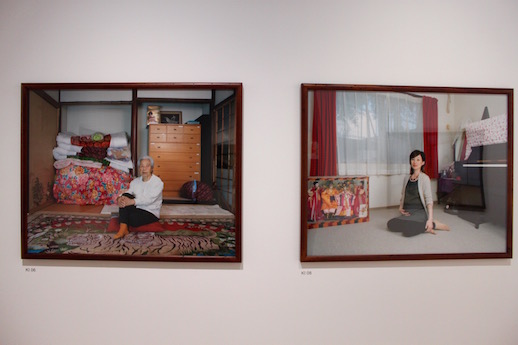
As the visitor embarks on the stories of these women, he or she is first greeted by In Grandmother’s House (2009), a photograph of a little girl dressed in pink traditional Korean dress in a Japanese home with tatami floors. This first image is followed by Son and I (2008), an image of a kneeling pregnant woman against a background displaying cultural Korean memorabilia. Unintentional or not, the young girl is reflected in this second image, staring back at the viewer and reminding them that this small child may also grow into a child-rearing woman. This first series of photographs continues with a juxtaposition of modern life and tradition, an artistic expression of Kim Insook’s individual identity as a third-generation Zainichi Korean.
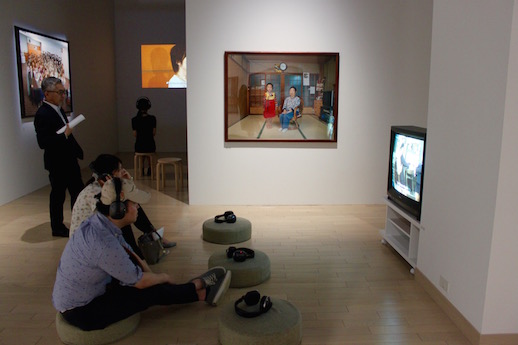
Kim Insook achieves her approach to communicating problematic issues of national and racial identity and community and family relations by filming interviews with the same Zainichi family photographed throughout the series. Visitors connect real voices, laughter and smiles to the the people photographed. The depicted are no longer simply subjects of a photograph but real people with stories to share. The medium of video on a television with headphones allows for a deeper connection between the viewer and the viewed. This section highlights the unique challenges of being Zainichi Korean citizens in Japan, and also is an uplifting example of how a community of love and acceptance can be a valuable lesson for both Japanese and Zainichi Koreans.
This initial connection established through sight and sound, however, is so effective and powerful that it perhaps prevents viewers from feeling an equally strong connection to the subjects of the following works. This is not to say that the remaining experience of the exhibit is not impactful. Rather, the swift transition from a gleeful and celebratory emotional state requires a more serious and analytical approach for the remainder of the show.
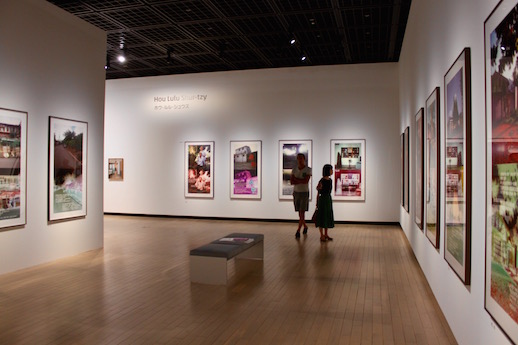
One such example of the visitor needing to fully engage on a mental level with the works is the section for Hou Lulu Shur-tzy, who was born in Chiayi, Taiwan and explores themes of gender, identity, social class and ethnicity. This particular series investigates four Military Dependents’ Villages in Kaohsiung, Taiwan after the Village Reconstruction Policy ordinance was passed to demolish the villages. The artist visited these villages and interviewed residents in an attempt to “preserve the cultural, physical and rhetorical memories.” She further states that the work is a critique of unjust policies behind the destruction of the inhabitants’ homes.
Visitors are confronted with desolate images from the villages as Hou Lulu Shur-tzy dramatically warps the photographs by applying a stark contrast in coloring—a visual representation of how the ordinance warped the lives of the villagers. Testimonies from villagers are written in Chinese characters with English translations provided in the exhibition text.
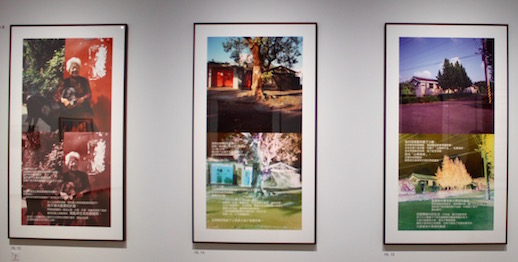
A later section shows an alarming photograph of an arm that has been self-injured. The light in the image strikes the blood as it glistens, perhaps making it seem as if the act of cutting oneself is idealized. The image, The Bearable: Birthday (2010) belongs to Chen Zhe’s series The Bearable (2007-2012), which deals with the concept of self-harm. Chen Zhe documents her history of self-inflicted harm and deeply contemplates existence itself. From the exhibition catalog, she quotes Sartre: “Remove existence from the self. Transpire the grease from time. Twist it hard, and wring it dry. It will make us pure and it will make us firm. So we could make clear precise notes like a saxophone.” The image ignites an active response as visitors are drawn to a diary-like book placed in front of the photograph. https://ebiteua.com/en/ We wonder: Does the diary provide answers about what’s going on in that image?
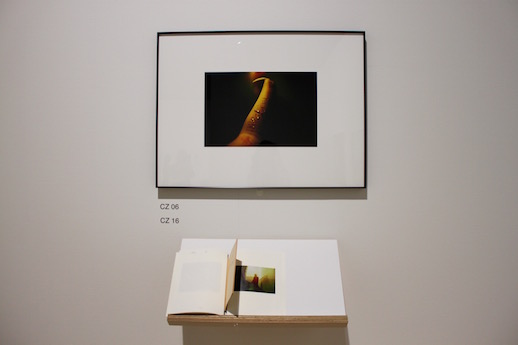
“I Know Something About Love, Asian Contemporary Photography” does a superb job of making the visitor feel fully engaged with the works. However, the order in which they are shown can feel a bit off-putting as the changing themes quickly demand a mental switch from the preceding section’s message to the next. It is worth mentioning that the museum took a bold approach in highlighting social issues that are culturally deemed untouchable for the average Japanese: mental health, issues of race or racism and disruption of life due to war and colonialism.
The Japanese title of the show is 「愛について – アジアン・コンテンポラリー -」and in English, it directly translates to “About Love – Asian Contemporary”. The definition of “love” is indeed multi-faceted and the stories each artist relates from her own realities are skillfully interwoven. Kim Insook, Kim Oksun, Hou Lulu Shur-tzy, Ayano Sudo, Chen Zhe and Geraldine Kang all have something about love to share.
Anyone who enjoys contemporary photography and is interested in art advocating for social change would appreciate this conceptually dynamic exhibition. Be aware it is sometimes necessary to refer to museum handouts to fully understand the contexts of the works. As they exit the show, visitors may find the stories behind the images linger and perhaps realize that they, too, have gained new understandings of love.
Emily Saya Niemann
Emily Saya Niemann



